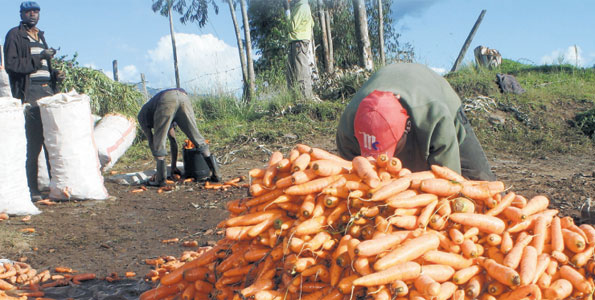Nyandarua County has the agricultural potential to feed the whole of Kenya, and become a tourist hub. It has however been lagging behind other counties simply because it lacks the means to realize the potential of its vast fertile soils, favourable climate and rivers that never run dry. Similarly, for years Nyandarua has experienced slow growth compared to other counties in Central Kenya because of very poor leadership.
This is a county that doesn’t seem to care so much about development, neither do its people seem bothered with the slow growth recorded year in year out. Take the county headquarters, Ol Kalou Town. Despite being the county’s business hub, this town can only be described as a God-forsaken centre where any radical developments are protested against by both leadership and the people themselves. For example, a roads contractor on the ground charged with the upgrading of some four kilometres of the town roads to bitumen standards has taken over four years. While the contractor identified as Donwoods has operated at snail’s pace, neither the county leadership nor the area residents have raised protests. On the country, this project has been the bane of bad blood between the county governor Francis Kimemia and the Ol Kalou MP David Kiaraho.
But the state of Ol Kalou and the surrounding estates has been in dire need of an uplift. When Kimemia came in as Governor, there was a consensus of hope that the town and the county at large would benefit gain development, thanks to his rich experience in the field of public service. This, though has remained a pipe dream. The town is poorly arranged with old buildings – some of which have now power connections – and no signs of any radical construction changes befitting a modern town status. At the heart of the town’s central business district is a market that represents all that is wrong with both the town and the county. Mark you, a market that has no business operating at the heart of uptown business.
Presently most of the fresh produce that is consumed in Nairobi is grown in Nyandarua County. Nyandarua County is surrounded by the Aberdares, one of the country’s water towers. And several major rivers originating from the mountains cut across the county making it one of the best watered lands in Kenya. And since rains are received all the year round, dairy farming also flourishes.
But without the right infrastructure — power and roads — most of these resources remain unexploited.
Nonetheless, improvements have been seen in the last few years following completion of the 100-kilometre Dundori-Ol-Kalou-Njabini highway by the Mwai Kibaki administration, and the Ol Jororok – Ndundori road by the Uhuru Kenyatta government that has opened up the agriculture-rich parts of the county to Nairobi, Nakuru and other towns. The Sh. 3.5 billion 100-kilometre Dundori-Ol-Kalou-Njabini highway has opened up the county to new markets. Land prices have also increased as more people seek to settle in the area.
The road connects the south and northern sections of the county, linking them with Nairobi and major towns. The road cuts across Ndundori, Tumaini, Ol Kalou, Wanjohi and Miharati in Nyandarua Central and Kipipiri districts, passing through Mawingu, Ndunyu Njeru and Engineer in North Kinangop. It ends at Njabi-ini Trading Centre in South Kinagop to link up with the old tarmac that runs from Fly Over area on the Nairobi-Nakuru Highway.
“Everything here has changed. Buyers come right to our farms to buy the produce, and it is now that we are realizing how important it is to own land here,” said farmer Margaret Kariuki of Tumaini. Mrs Kariuki owns 25 acres, which she says would not have attracted any buyers five years ago.
At the time, Mrs Kariuki recalls they used to sell an extended bag of Irish potatoes for Sh. 300 or less since vehicles transporting the farm produce would take days to reach the market in Nairobi.
And instead of going to waste, part of the harvest including cabbages, kale and carrots would be given to livestock. “Today we sell an extended bag of potatoes at between Sh. 1,000 to Sh. 3,000 as buyers come all the way from Nairobi and even Mombasa,” Mrs Kariuki said.
Milk prices have also changed as farmers are finding it easy to reach the market in Nakuru through the 17-kilometre Lanet-Dundori road that connects with the Nakuru-Nairobi Highway. “Currently, a litre of milk is going for Sh. 30. And this is a great improvement to us, since for long we did not have market for our milk, which we would either feed to dogs or empty it on the ground,” Mrs Kariuki said.
The whole area reached by the new road is very rich in agriculture and it is one of the leaders in dairy farming. With the improved market for crops, demand for land has gone up. Five years ago an acre in Ndundori, Tumaini or Ol Kalou was less than Sh. 60,000, revealed Mr Gichuki Githinji.
“I bought my two acres at Sh. 80,000 in 1995. At the time, very few people wanted to buy land here as roads were impassable for most parts of the year,” he said, and added that the same land is now Sh. 300,000 an acre.
To take advantage of the new nearness to markets, some farmers have tried horticulture and fish farming instead of relying on traditional tubers and vegetables. Mr Josephat Kinyanjui, the chairman of Mahiga-ini fish farmers self-help group in Wanjohi, helps to run 47 fish ponds that the Fisheries ministry built for them.
They were also given fingerlings and two nets for catching the fish, plus training on how to prepare fish for food. The group has started to explore markets for their fish in big towns and meanwhile they are encouraging local people to eat more fish. “Since we can easily reach the local towns and trading centres given that there is a tarmac road, we have managed to establish local market for ourselves,” he said.
One of the markets is Miharati Trading Centre, the headquarters for Kipipiri District. Traders from throughout the country are buying fish in the area. “When we settled here in the 1960s, there were a lot of trout in Wanjohi River and the white settlers had taught people how to fish and prepare them for food,” Mr Kinyanjui recalled.
The state of medical infrastructure, and in particular, the county referral hospital in Ol Kalou town has also been called to question. Other than the infrastructural expansions carried out by the previous county government, there has been little to nothing under the current Governor. Yet, just like other counties, Nyandarua has never missed its annual allocation of funds.








